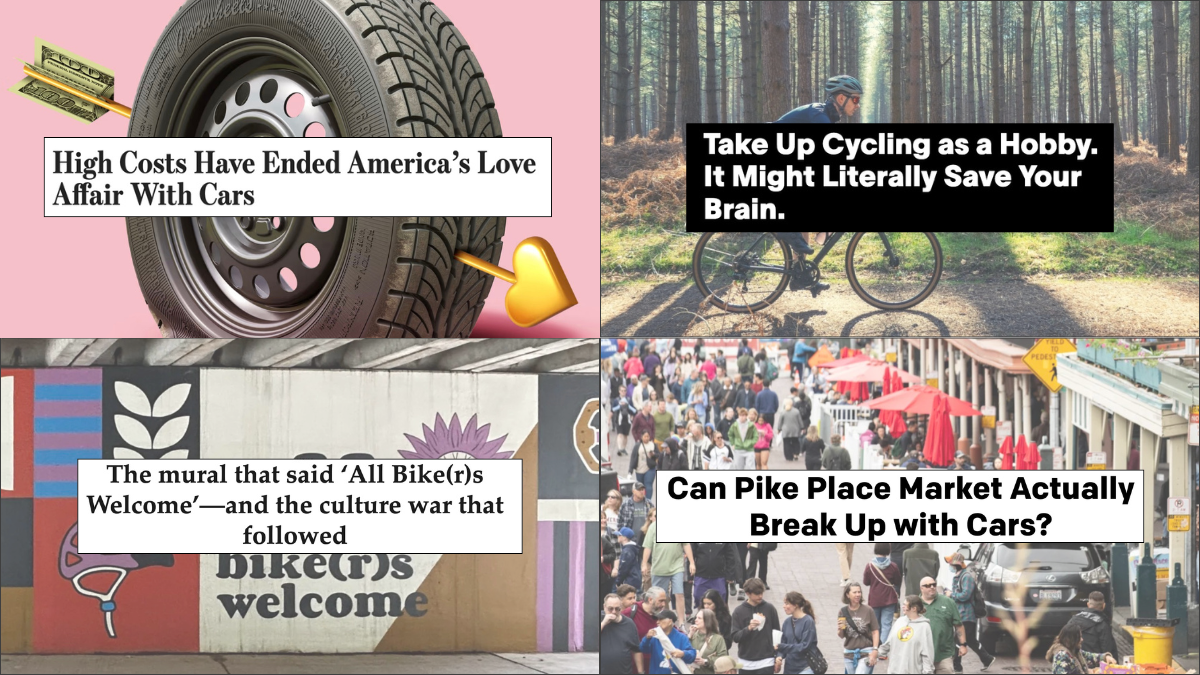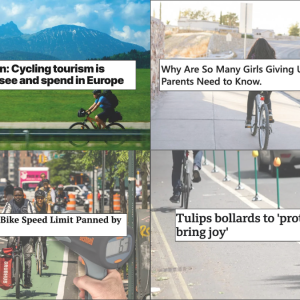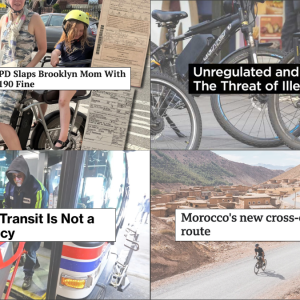Hi friends (and everyone else).
I’m three days post-surgery on my second knee replacement and I’m feeling OK. I plan to work when I can, but things could be touch-and-go for the next week or so depending on a combination of factors like pain, the effects of my pain meds, and so on. The great news is that in a few weeks I’ll be on my way to a new chapter in my life. One where my knees are healthier and I can move through the world with more confidence. I’m excited, but I’ve gotta’ get through this tough slog first. Thanks for your patience and understanding.
Here are the most notable stories that came across my desk in the past seven days…
In defense of vision zero: After a newspaper’s editorial board labeled Boulder’s quest for vision zero “juvenile,” an advocate responded with a very thoughtful and effective defense of the road safety approach that Portlanders would be wise to read. (Daily Camera)
A mural and a culture war: A colorful mural with the message “All Bike(r)s Welcome” touched off a huge controversy in Bentonville, Arkansas — a city that prides itself on being the most bike-friendly in America. The debate revealed a clash of cultures in a city full of contradictions. (Cycling Weekly)
Parking wars: People in a U.K. town have resorted to blockades and physical altercations as they fight against an “invasion” in car parking from a nearby neighborhood. It’s a war on cars IRL. (Birmingham Mail)
Parade death: A truck carrying one of the U.S. Army tanks used in Trump’s military parade ran over and killed a pedestrian on the streets of Washington D.C. (USA Today)
Pike Place pedestrianization: Seattle’s iconic public market finally went carfree because their mayor stood up and wanted to make it happen. So far it appears to be going very well. (Seattle Met)
Hypercar hypocrisy: It is totally absurd that we allow automakers to sell “hypercars” that go 0-60 mph in under two seconds regular people to be used on public streets. Seriously. When will a leader step up and say enough is enough? No regulatory agency that stands by and allows these products to be sold should be considered credible when it comes to discussions of road safety. (CNBC)
An expensive addiction: This article is an excellent overview of the many ways cars have become even more expensive to own in recent years, and it helps explain why city leaders and planners have an opportunity to swoop in and give folks options to ditch driving for good. (Wall St. Journal)
Cycling and dementia: A major new study shows that people who cycle regularly into older age are less likely to have dementia because their brains stay sharper and more active. (Vice)
Damn allergies: A pro cyclist decided to end his career because his allergies were so overwhelming. I’m sure a lot of folks in Portland can relate! (Cycling Weekly)
Thanks to everyone who sent in links this week. The Monday Roundup is a community effort, so please feel free to send us any great stories you come across.








Thanks for reading.
BikePortland has served this community with independent community journalism since 2005. We rely on subscriptions from readers like you to survive. Your financial support is vital in keeping this valuable resource alive and well.
Please subscribe today to strengthen and expand our work.
The article about Vision Zero in Boulder was behind a paywall for me, but I found a version that was not here: https://www.reddit.com/r/boulder/comments/1lgvta3/guest_opinion_michael_mills_vision_zero_is/
Re: Vision Zero, The Hoboken and Jersey City stats are impressive! Our city leaders ought to read this.
No to discount or minimize Hoboken or Jersey City, but the city limits of New Jersey municipalities (especially on the west bank of the Hudson) make Vision Zero a much easier task. Hoboken is just 1.25 square miles, about the same size as Downtown Portland. I’m sure our city leaders could learn a lot, but Hoboken has no 82nd (or 122nd or 148th or 162nd, etc.) Avenues.
And it’s easy to say “allow more density to improve walkability” but Hoboken and Jersey City are so strongly influenced by the NYC job market that it hardly feels relevant in Portland. We could allow infinite density everywhere in the city but that won’t bring jobs to town in the numbers to justify building like Jersey City and Hoboken do
Few important notes on JC:
1) There are still quite a few deaths on roads within JC proper, but are controlled by NJDOT and not the city. The 14th and 12th couplet to the Holland Tunnel is still death race 2000.
2) Years ago Mayor Steven Fulop and the council decided to place interim designs (e.g., temporary roundabouts) to gauge their effect on safety. Because physical pilots give people an idea of what the actual results might be, and gain support for subsequent capital projects. PBOT rarely does this.
3) Major thoroughfares, such as Washington, Grand and Columbus, had either standard, or no infra for bikes >5 years ago. I avoided them like the plague or rode the sidewalks. Now they have PBLs. In the last 10 years JC has taken major steps to expand it’s separated network in the city center, but outside that, it still has a long way to go. If the Bergen Arches and old train lines get turned into MUPs to connect to places elsewhere in NJ, it’ll be a regional biking hub.
Oof, honestly those Holland Tunnel approaches are insane. Seems like a slam dunk to just extend the tunnel to the 139/I-78 interchange to me.
I guess I mostly mean to say that there are specific project things to learn, but for bigger picture things the west bank of the Hudson has such vastly different land use constraints that it makes direct comparison difficult.
And on the old train lines to paths – I think the New York area is a place where there’s almost certainly demand for improved rail transit over bike paths, and that those lines should be prioritized for transit over biking in general.
For real. Agreed on both.
Don’t wanna get in the weeds too much, but keep in mind the heights have been poked through a million times over the last couple centuries and the NE corridor/Gateway Tunnel program is just one of a dozen-ish tunnels. The Hoboken main line literally passes over the Bergen Arches at the West end and the Path is just a few blocks south. So I see your point, and light rail is being considered along with other stuff, but it’s also a bit (but not entirely) redundant IMO unless they can get the CSX? line along Tonnelle. I think the best short term scenario is getting the trail connected to the old Boonton line to Montclair. Best case scenario is they go hog wild and do it like they do in the other Bergen.
Until TriMet ends its addiction to the inflexible trains, Portland will never have a fully functional transit system that would be flexible with buses. Only then might people let someone else drive rather than themselves. Yes, driving is expensive, but until there’s a better alternative people will continue to, and currently TriMet is not a better alternative.
TriMet runs tons of great buses, and for at least two of the segments of the MAX (along the Banfield and between Hillsboro and Portland) it’s probably too busy to economically run buses instead. Not to mention, it would be pretty expensive to convert the railways to busways. Plus, running diesel buses in a tunnel is a no go.
Some MAX lines/segments have been built without the ridership justification, but that’s often because regional funding politics and (occasional) poor routing choices have crippled them. The Yellow and Orange lines are particularly affected of this, as the original South/North project ran into anti-light rail sentiment in Clark County, and later Clackamas County.
The issues with the MAX and TriMet in general do not come from a lack of flexibility, but from a few historical strategic missteps and the general challenges with transit funding and ridership in the US (especially sprawly lane use patterns).
Ah yes, if we ever want to have transit ridership similar to London, New York, or Tokyo, we have to give up our addiction to those silly trains, which they definitely don’t have in places where more people embrace public transportation.
You’d be shocked at the number of European and Asian cities that are completely covered in inflexible trams and light rail lines, but still manage to provide great transit access. Your weird obsession with MAX has been noted.
60 miles of track, 95 stations (according to Google AI).costing over $2 billion to build. That’s not a network. It’s 6 lines meeting in 3 hubs.
Poor connectivity to buses (from the 2nd red line of the day to the 1st 72 is a 15 minute wait. On staturdays it’s 25min+)
Out of the way stations due to taking the path of least resistance (cost) down freeways. Ride a shuttle someday when the MAX is down to get a real appreciation of how off the beaten track these are.
Really poor fault tolerance – a single incident in the wrong spot jams 80% of the “network”.
Now, take that $2bn (not adjusted to 2025 dollars) and 40 years and tell me we wouldn’t have a far more complete network if it were BRT. More fault tolerant due to buses being able to go around incidents and due to more lines closer together. Less need to go *WAY* out of your way to use the MAX (try using it to go from Beaverton to Clackamas).
Yes, I know that BRT has higher operating costs, but also isn’t as affected by climate change (they had to revamp all the heat compensating counterweights and they still don’t handle common summer temps these days). The MAX requires tens of millions of dollars in maintenance yearly.
Not an obsession, just observations from decades of riding the MAX.
It actually is, in fact a network. It might not be a comprehensive network, but it’s certainly a network. Also, next time you could just use Wikipedia rather than have Google summarize it for you.
While there are instances of poor connectivity in many places, there are only so many coordination points a transit network can reasonably manage. It’s entirely possible that the trip you are describing can’t be properly coordinated due to more pressing transfer coordination elsewhere in the network. Though to be fair, I’ve yet to see great evidence of TriMet of spending a significant deal of effort on specific timed transfers.
These are both emblematic of a primary drawback of light rail planning in the US – not having enough money and taking shortcuts. It’s an inherent trade off to the mode, but it’s one that is not unambiguously bad. I prefer Portland’s imperfect but substantial light rail network to Milwaukee’s complete lack of regional transit. And highway right of way reuse is a standard operating procedure for public transit in all parts of the world for good reason. It’s better to build more transit in less expensive places than to build less transit in more expensive places.
This is a bit of a false equivalency, since there is no reason to believe that those dollars could have been exchanged in-kind. A core funding justification, especially for the early MAX lines, was the fact that they were trains. FTA support was critical to the building of those lines, and the FTA didn’t really fund BRT/quasi-BRT with gusto until well into the 2000s. Plus, outside of a few quality examples (Eugene, Albuquerque) American BRT is barely an upgrade from a bus. Yes, it’s technically possible to build the CDMX Metrobus in Portland, but we as a society have generally not shown a willingness to do so.
There is no reason to think that a regional BRT network, even a very comprehensive one, would significantly alter this specific trip. Even on the highway network, this is a 25 mile trip for a 12 mile distance as the crow flies. Any route between Beaverton and Clackamas on transit would almost certainly go via downtown Portland regardless of the mode – there just isn’t the intermediate ridership demand via any other route (except maybe the 205 route via Tualatin and Oregon City, but that’s not any less out of the way).
I would also say the climate-change related vulnerabilities of the MAX lines are generally overstated and made out to be a larger issue than they are based on a deeply conservative corporate culture at TriMet. While looking into this, I have realized that they’ve gotten less conservative in their hot weather protocols (potentially as a result of recent upgrades), which you can see by contrasting 2015 press releases (35 mph limit across the board at 90), with 2022 protocol (10 mph reductions on certain Orange/Green line segments), with current protocol (35 mph across the board at 100). The 100 degree mark seems to be much closer in line with policy I found for other agencies, and realistically this always should have been the benchmark (Portland’s number of 100 degree days has increased, but it didn’t increase from zero and this should have been factored in at the time the lines were built)
It’s fair to say that the MAX has substantial issues, but few of these have to do with the fact that they are trains. Maintenance costs are higher, but the fully allocated cost per rider of each MAX line is only slightly higher than an equivalent bus service (Spring 2024 data), and was less expensive pre-Covid (Spring 2019 data). Insofar as the MAX network design is inadequate for our post-Covid city I think is fairly debatable, but this is most evident for the newer lines that have generally worse/slower design and have had much less time to take advantage of new developments. I see the biggest issues facing the MAX network being the relative uselessness of the Orange Line as currently built and the longstanding issues relating to slow time through downtown and the Steel Bridge bottleneck. Those are all fixable problems, but they won’t fix themselves and it will take some good planning and leadership to make them happen.
$2 billion is the cost of less than 2 miles of Rose Quarter freeway expansion. I’d say 60 miles of MAX light rail is pretty good value in comparison. The light rail vs. BRT issue is a false dilemma when highways are the real money pit.
Vision Zero: Since I moved to the East Coast from Portland in 2015, about 10 years ago now, I have periodically visited and biked around Washington DC, including this last weekend. From what I have observed is that the city government has been gradually removing traffic lanes and car parking, steadily replacing them with bike lanes, bus lanes, and gores (hatched lines). As the available space for driving and storing cars has declined, more people are out walking, bicycling, and using the excellent public transit system there. In the inner high-density parts of the city, the old painted bike lanes had candlesticks added 5 years ago, but now come standard with curb barriers of various sorts, as well as bus-stop/bike-lane combo structures, and some parking-protected bike lanes. Traffic streets are gradually being put on diets of one-lane each way as car counts drop, and the more streets that get new diets seem to be having a cumulative effect of driving the total volume of car drivers down citywide. There’s congestion in DC of course, but even that is declining and getting shorter in duration, while drivers seem to be moving slower, even as so many drivers (and bicyclists) ignore traffic signals – they might as well be replaced with stop signs for all the good they do on the dieted street intersections. DC is steadily becoming easier and safer to bike and walk in.
So if PBOT were serious about reversing carcentric behavior they should simply start to do the same in Portland rather than talk and talk and hold committees about it?
A pleasantly direct and sustainable idea.
Could you expand your idea about traffic signals? I’m not sure I get it. Have signals become unnecessary for cars, locally?
Maybe we should start marketing automobiles with slogans like, “Looking to GREATLY INCREASE your chances of getting dementia? Then this vehicle is for you!”
Although I guess in the case of the new “hypercars,” the slogan can be amended to “Looking to GREATLY INCREASE your chances of maiming or killing a child or adult while ALSO getting dementia? Then this vehicle is for you!”
Can’t believe Pike Place wasn’t pedestrianized years ago honestly. Every time I’ve been it’s seemed like at least 80% of traffic was just people who put “Pike Place Market” into their mapping app of choice and expected to be able to park right out front. But hey, better late than never!
I was in Seattle this weekend and pedestrianized Pike Place is lovely. It should stay that way.